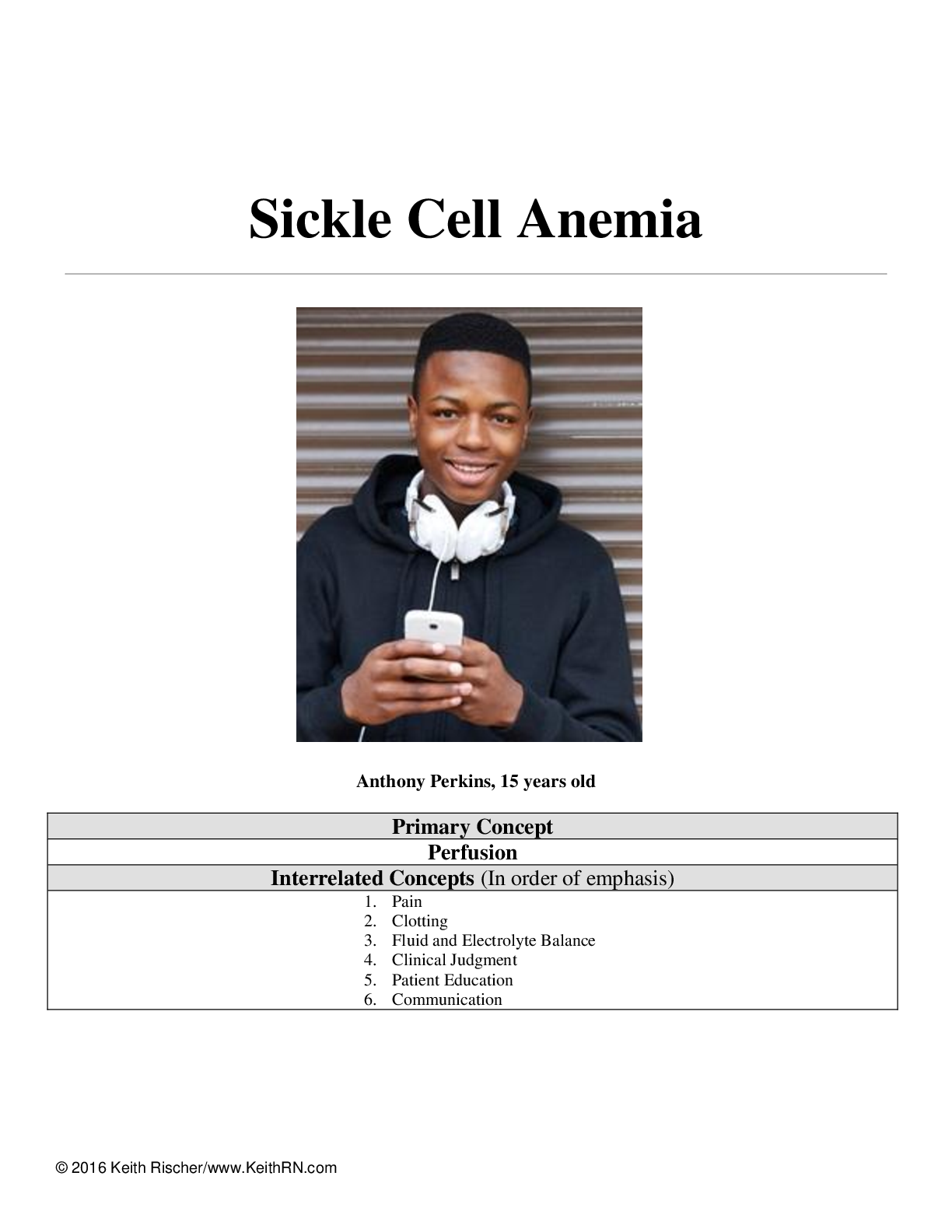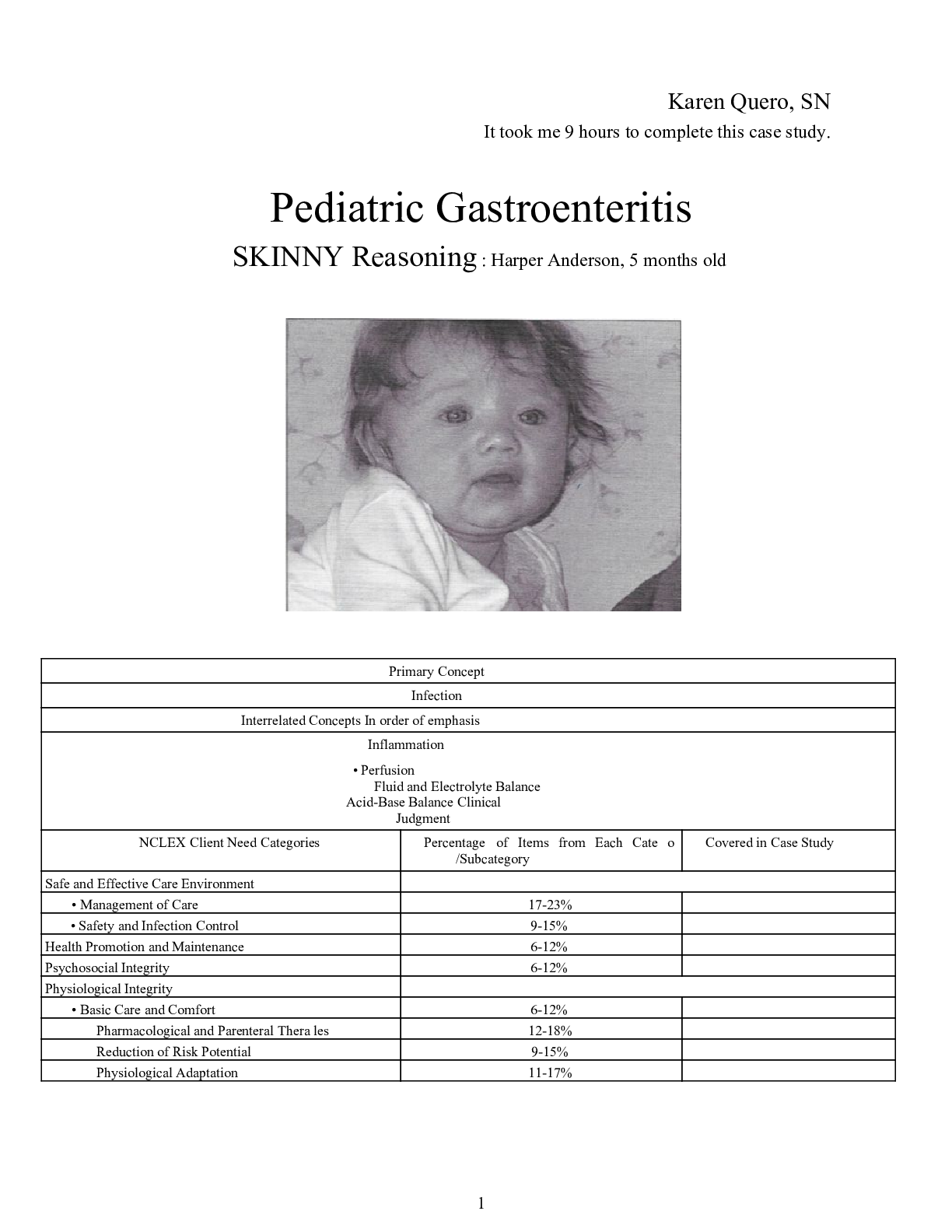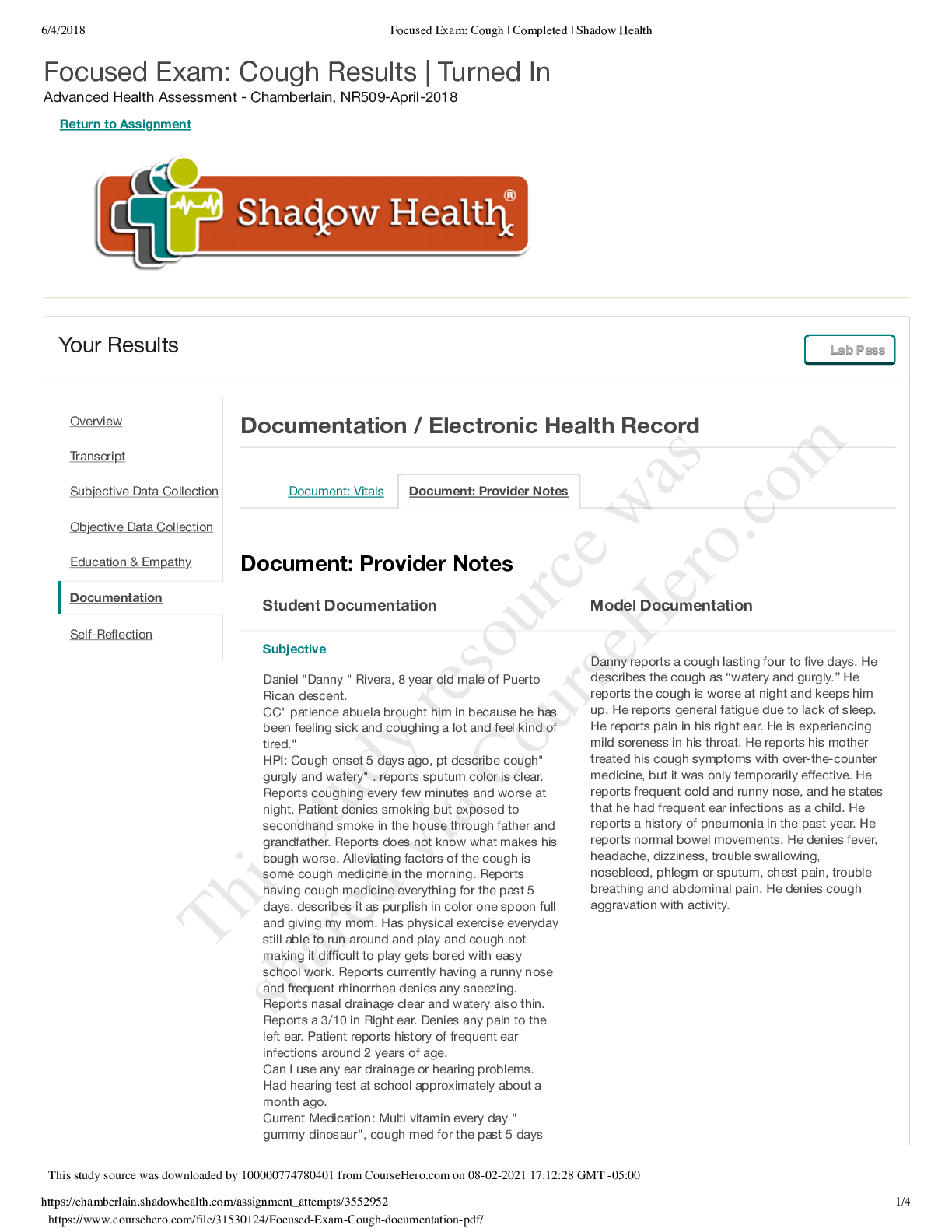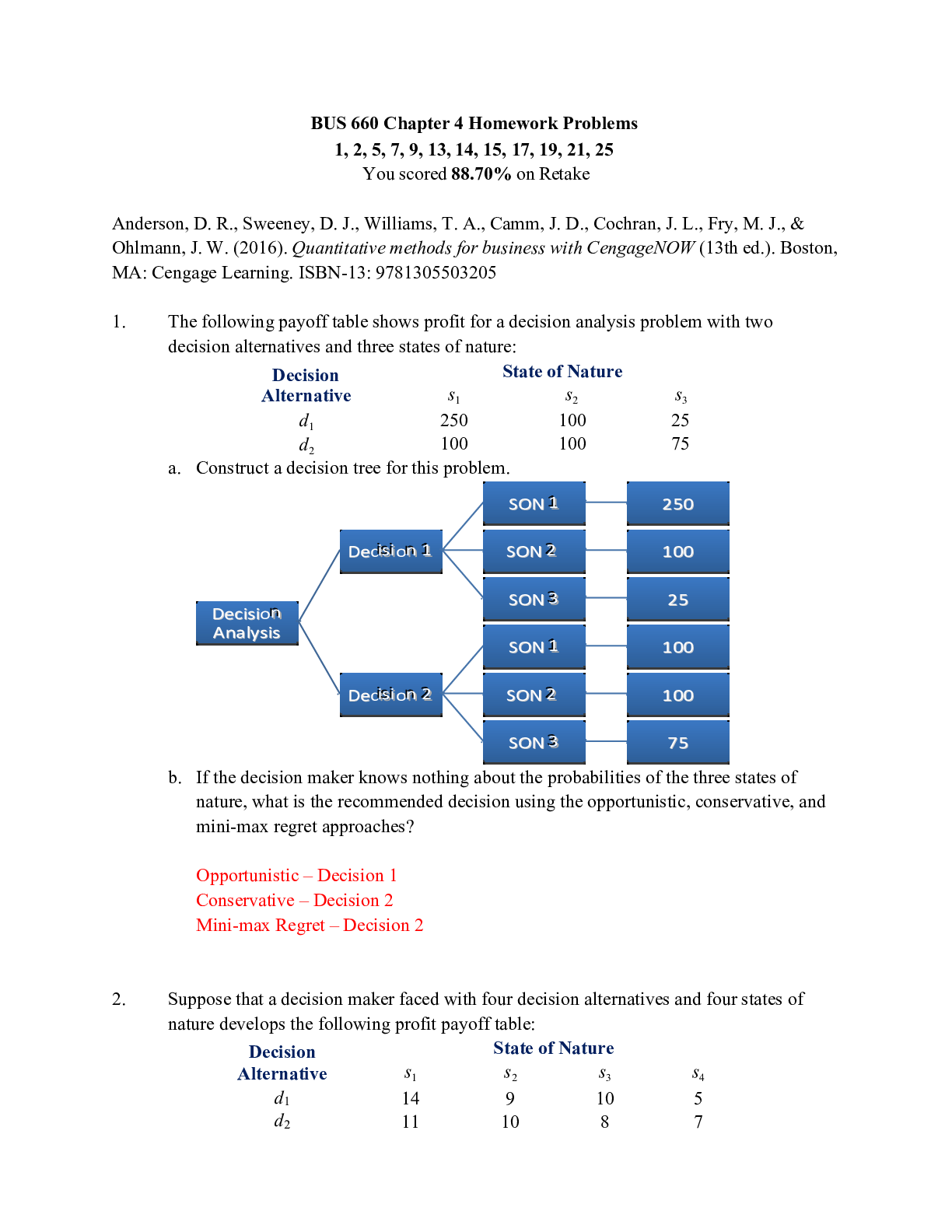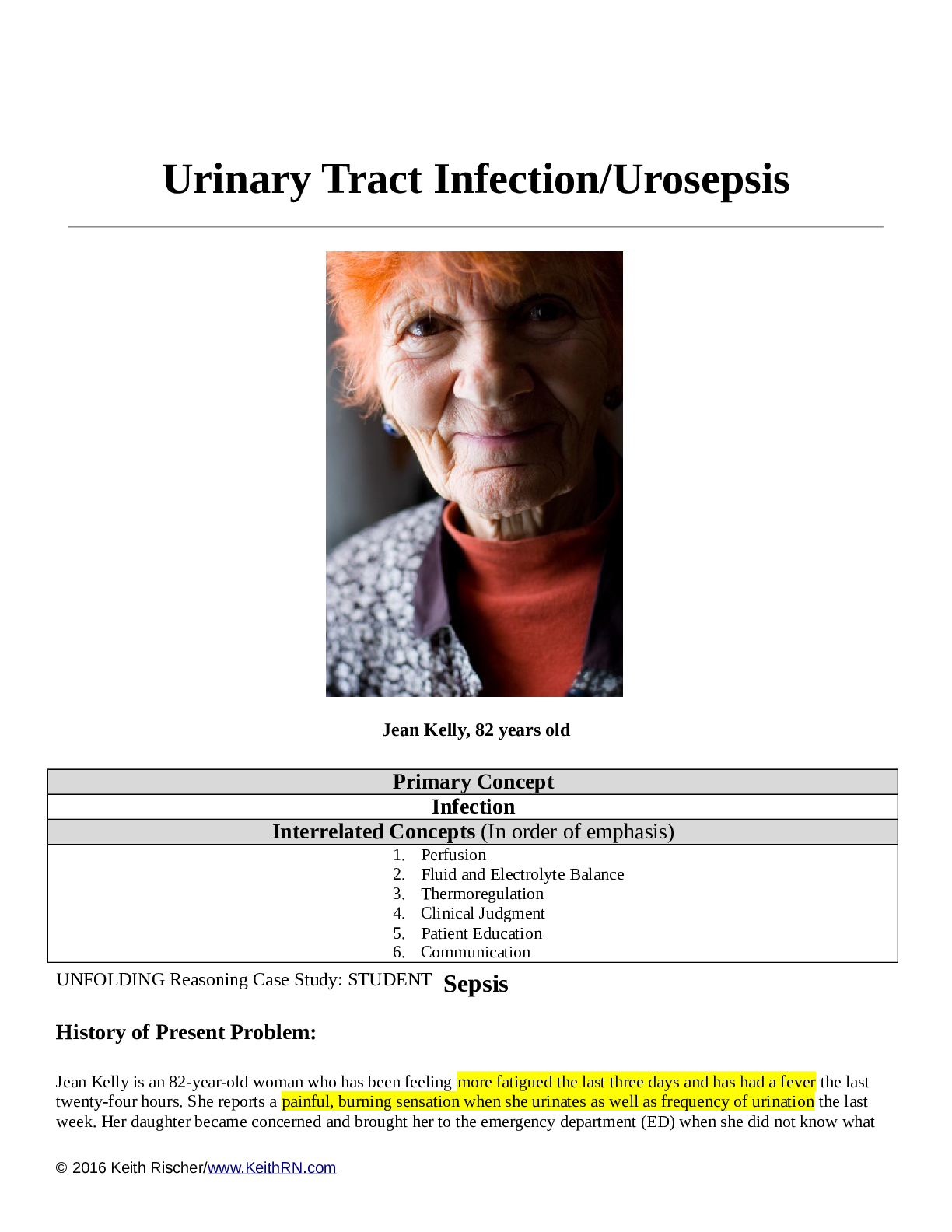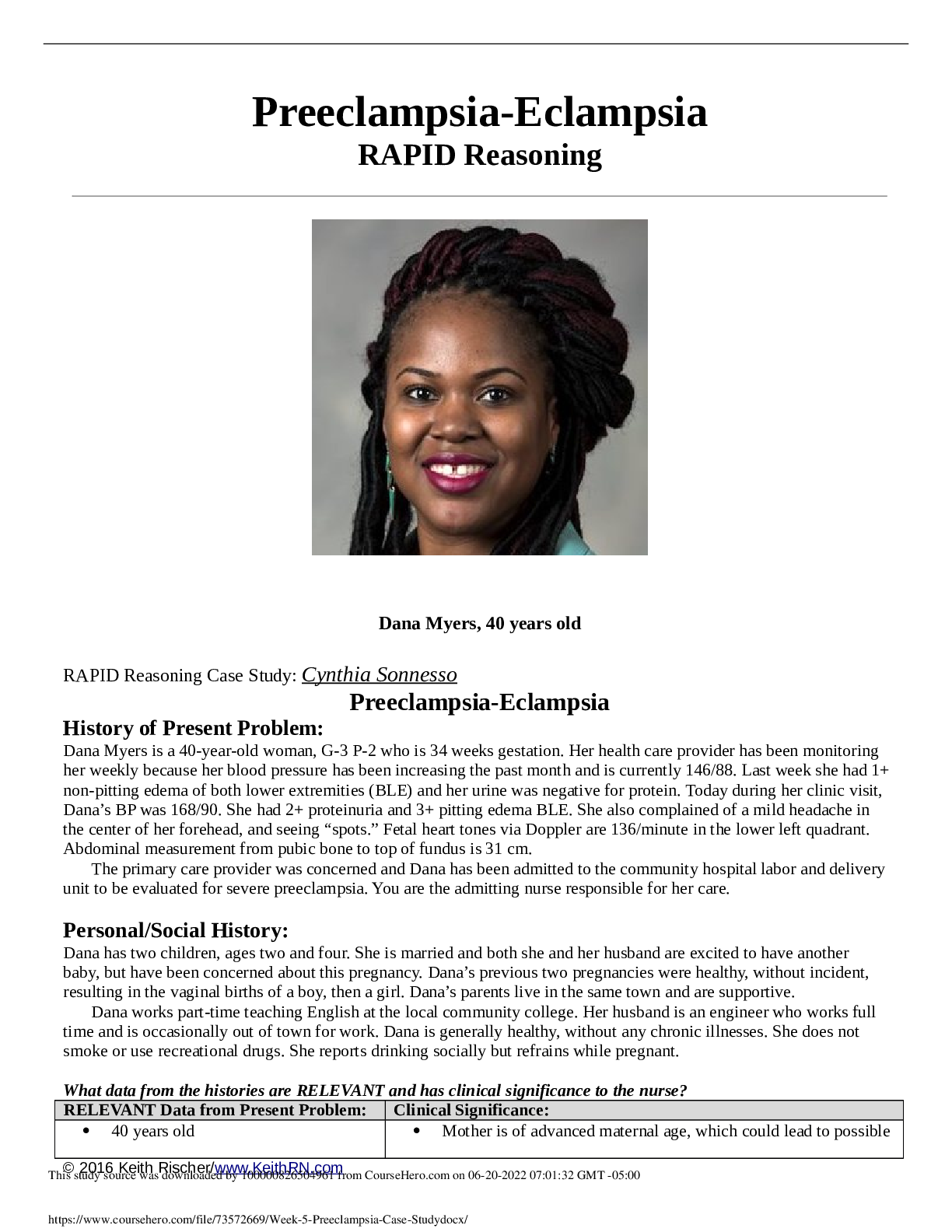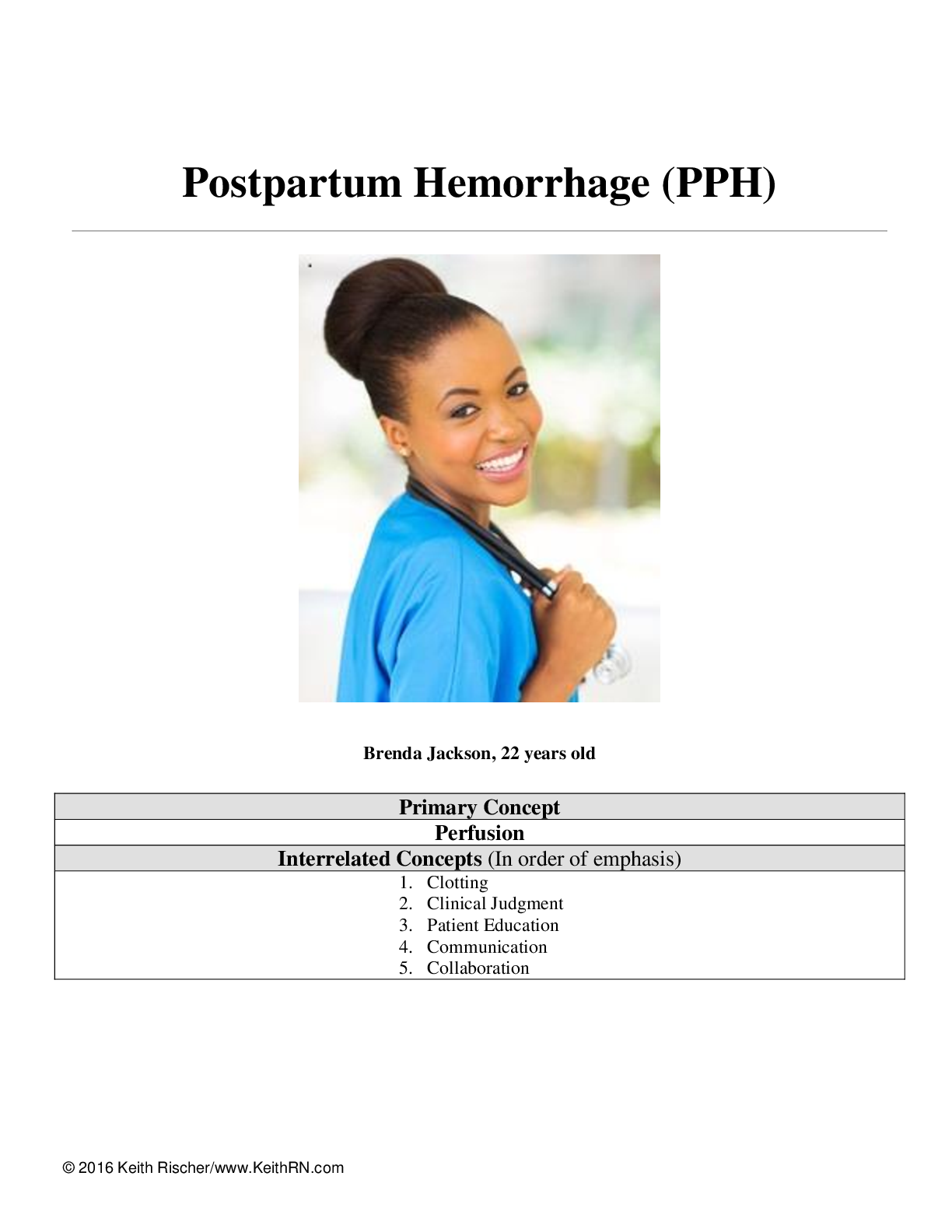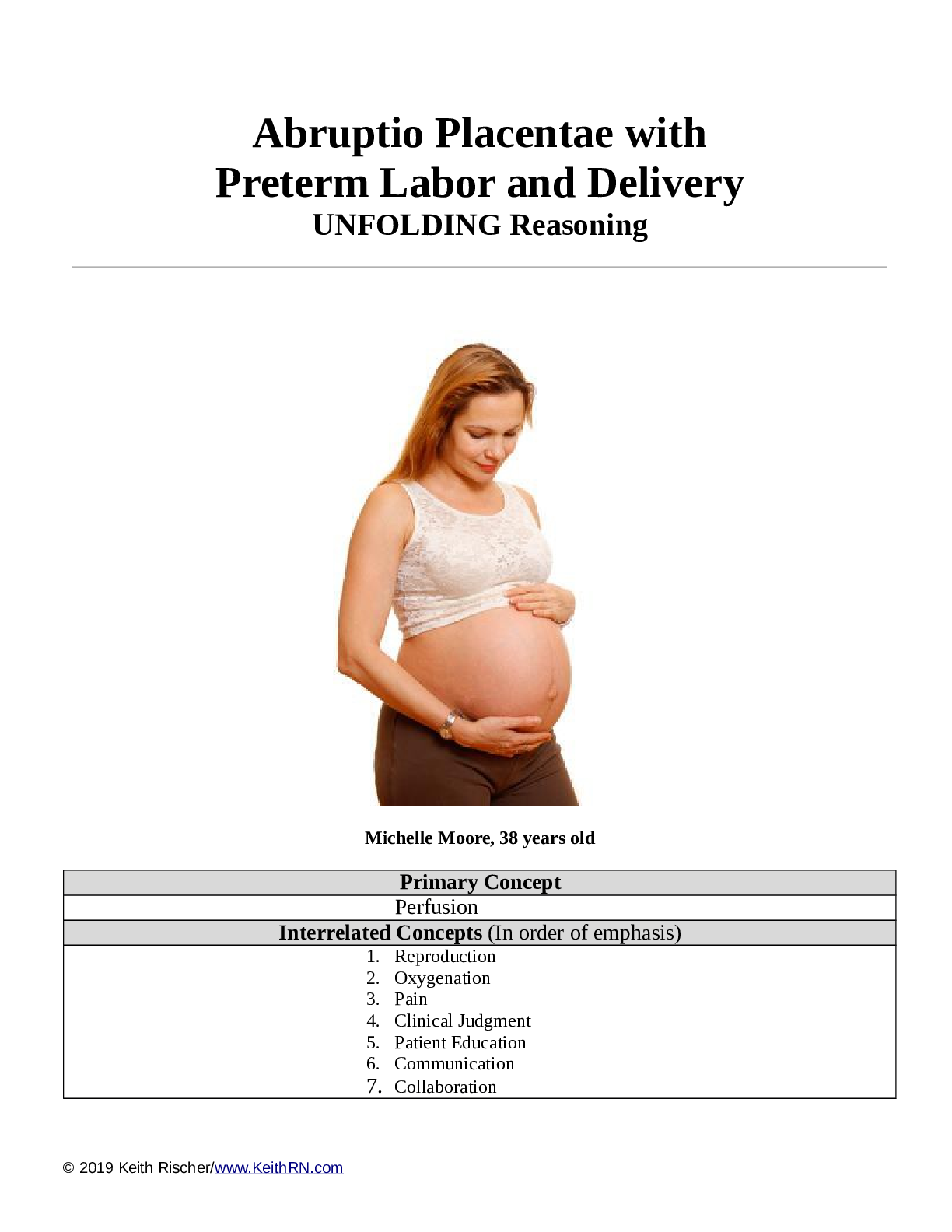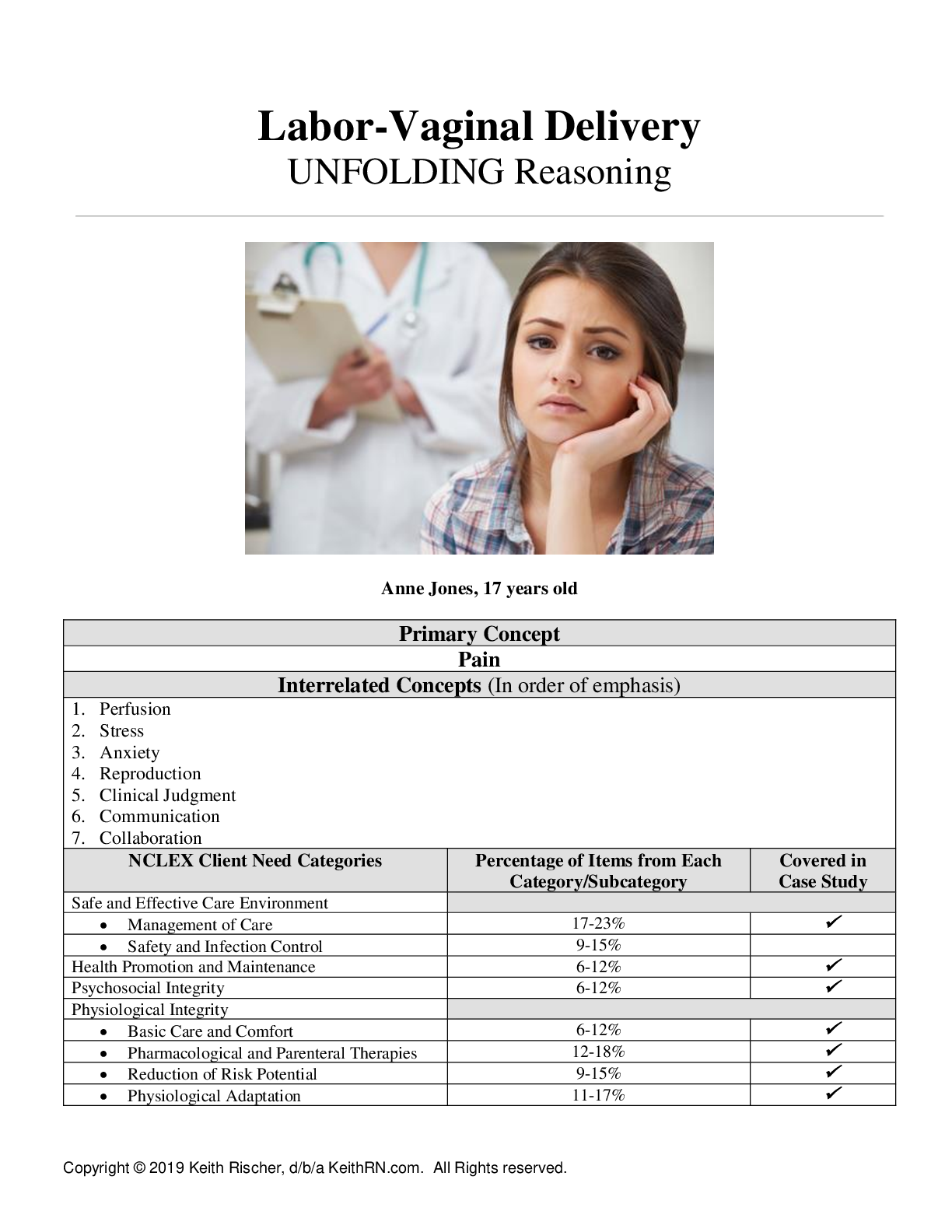*NURSING > SHADOW HEALTH > Oral and Parenteral Medication Administration Skills & Reasoning Jerry Williams, 62 years old (All)
Oral and Parenteral Medication Administration Skills & Reasoning Jerry Williams, 62 years old
Document Content and Description Below
Oral and Parenteral Medication Administration Skills & Reasoning Jerry Williams, 62 years old 1 Oral and Parenteral Medication Administration Skills & Reasoning Jerry Williams, 62 years old Pr... imary Concept Perfusion Interrelated Concepts (In order of emphasis) x Gas Exchange x Clinical Judgment x Patient Education NCLEX Client Need Categories Percentage of Items from Each Category/Subcategory Covered in Case Study Safe and Effective Care Environment 9 Management of Care 17-23% 9 9 Safety and Infection Control 9-15% Health Promotion and Maintenance 6-12% 9 Psychosocial Integrity 6-12% 9 Physiological Integrity 9 Basic Care and Comfort 6-12% 9 9 Pharmacological and Parenteral Therapies 12-18% 9 9 Reduction of Risk Potential 9-15% 9 9 Physiological Adaptation 11-17% 9 This study source was downloaded by 100000826504961 from CourseHero.com on 06-20-2022 06:23:57 GMT -05:00 https://www.coursehero.com/file/60334924/STUDENT-Medication-Admin-Skills-Reasoningpdf/2 History of Present Problem: Jerry Williams is a 62-year old obese (BMI 35.2) Caucasian male with a history of diastolic heart failure and type II diabetes. Last evening, he began having difficulty breathing with activity. He thought he might be getting a cold because he had a runny nose. He reports more swelling in his lower legs the past couple days. He woke up this morning with increased difficulty breathing when he woke up and his wife called 911. Paramedics report that his initial VS: HR:92 RR: 28 BP: 172/88 O2 sat: 80% on room air with scattered expiratory wheezing bilat. He was placed on oxygen by facemask and albuterol nebulizer administered with some improvement in his breathing. His RR is now 24 upon arrival to the emergency department ED). His initial labs have resulted; creatinine of 2.5 (last adm. 1.8), K+ 3.5 (last adm. 3.7) and BNP 944 (last adm. 322). Jerry is given furosemide 40 mg IV in the ED and had 800 mL urine output in the last hour. He is admitted to cardiac telemetry, and you are the nurse responsible for his care. What data from the present problem do you NOTICE as RELEVANT and why is it clinically significant? (Reduction of Risk Potential/Health Promotion and Maintenance) RELEVANT Data: Clinical Significance: What is the RELATIONSHIP of his past medical history and current medications? Why is your patient receiving these medications? (Which medication treats which condition? Draw lines to connect) Past Medical History (PMH): Home Medications: Hyperlipidemia Hypothyroidism Type II diabetes Diastolic heart failure Chronic kidney disease stage III Furosemide 20 mg PO every morning Atorvastatin 40 mg PO at bedtime Metoprolol 50 mg PO BID Levothyroxine 112 mcg PO daily Exenatide microspheres 2 mg subq. weekly Nursing Assessment Begins: Current VS: Most Recent in ED: P-Q-R-S-T Pain Assessment: T: 98.2 F/36.8 C (oral) T: 98.8 F/37.1 C (oral) Provoking/Palliative: P: 88 (reg) P: 92 (reg) Quality: Denies R: 24 (reg) R: 24 (reg) Region/Radiation: BP: 142/76 BP: 148/80 Severity: O2 sat: 93% 4 liters n/c O2 sat: 94% 4 liters n/c Timing: 1. obese, type II diabetes, Diastolic heart failure 2.shortness of breath with activity/ increased difficulty breathing when he woke up 3.more swelling in his lower legs 4. High RR and BP and low O2 sat 5. high creatine and BNP labs 1. shows that patient was not in the best health before these problems began 2.shows that there is something going on with his gas exchange 3. could be a problem with purfusion, possible DVT 4. proves that hes is having difficulty breathing and his heart is trying to pick up the slack 5. increase risk for kidney and heart failure This study source was downloaded by 100000826504961 from CourseHero.com on 06-20-2022 06:23:57 GMT -05:00 https://www.coursehero.com/file/60334924/STUDENT-Medication-Admin-Skills-Reasoningpdf/3 What clinical data do you NOTICE that is RELEVANT and why is it clinically significant? (Reduction of Risk Potential/Health Promotion and Maintenance) RELEVANT VS Data: Clinical Significance: TREND: RELEVANT Assessment Data: Clinical Significance: TREND: 1. INTERPRETING relevant clinical data, what is the primary problem? What primary health-related concept(s) does this problem represent? (Management of Care/Physiologic Adaptation) Current Assessment: GENERAL SURVEY: Pleasant, in no acute distress, calm, body relaxed, no grimacing, appears to be resting comfortably. NEUROLOGICAL: Alert & oriented to person, place, time, and situation (x4); muscle strength 5/5 in both upper and lower extremities bilaterally. HEENT: Head normocephalic with symmetry of all facial features. PERRLA, sclera white bilaterally, conjunctival sac pink bilaterally. Lips, tongue, and oral mucosa pink and moist. RESPIRATORY: Breath sounds coarse crackles in bases bilat.with equal aeration on inspiration and expiration in all lobes anteriorly, posteriorly, and laterally, nonlabored respiratory effort. CARDIAC: Pale/pink, warm & dry, 2+ pitting edema in feet and ankles, heart sounds regular, pulses strong, equal with palpation at radial/pedal/post-tibial landmarks, brisk cap refill. Heart tones audible and regular, S1 and S2 noted over A-P-T-M cardiac landmarks with no abnormal beats or murmurs. Unable to assess JVD due to obesity/thick neck ABDOMEN: Abdomen round, soft, and nontender. BS + in all four quadrants GU: Voiding without difficulty, urine clear/yellow INTEGUMENTARY: Skin warm, dry, intact, normal color for ethnicity. No clubbing of nails, cap refill <3 seconds, Hair soft-distribution normal for age and gender. Skin integrity intact, skin turgor elastic, no tenting present. Problem: Pathophysiology of Problem in OWN Words: Primary Concept(s): . Pulse decreased BP decreased O2 sats decreased by 1% He is more calm, less work on heart Less work on heart trying to pick up slack may need O2 adjusted work on heart is decreasing, may need re-evaluated for a higher liter Respiratory: crackles Cardiac: 2+ pitting edema Fluid is in lungs fluid in cells tissues increased buildup of fluid Pulmonary embolism Cardiac, Perfusion, respiratory Patient had a DVT, which was the cause for the swelling he noticed in his legs. The DVT dislodged and moved up to lungs creating a pulmonary embolism. This is the cause of the shortness of breath and crackling lung sounds This study source was downloaded by 100000826504961 from CourseHero.com on 06-20-2022 06:23:57 GMT -05:00 https://www.coursehero.com/file/60334924/STUDENT-Medication-Admin-Skills-Reasoningpdf/4 2. What nursing priority(ies) will guide your plan of care that determines how you decide to RESPOND? (Management of Care) Nursing PRIORITY: PRIORITY Nursing Interventions: Rationale: Expected Outcome: Medical Management: Admission Medication Orders Care Provider Orders: Mechanism of Action: Expected Outcome: Administer the following home medications: Atorvastatin 40 mg PO daily Metoprolol 50 mg PO BID Levothyroxine 112 mcg PO daily New order: Heparin 5000 units subq. BID Medication Administration 1. IdeQWif\ Whe ³UighWV´ of safe medication administration? Promote patient activity Assist patient to sit up in bed, chair, or go for short walks The movement will prevent other clots from forming. Immobilty will increase the risk of more clots and pneumonia. Sitting up will allow for easier breathing and other clots will not develop. A:inhibits rate-limiting step in cholesterol biosynthesis by competitively inhibiting HMG-CoA reductase M:blocks response to beta-adrenergic stimulation L: Synthetic T4; increases thyroid actions H: inhibits the conversion of prothrombin to thrombin A: lower lipid levels M: Lower the risk of heart attack L: raise the level of tyroid hormone H: decreases the clotting ability, and can reduce the size of a clot right patient right route right medication right time right documentation This study source was downloaded by 100000826504961 from CourseHero.com on 06-20-2022 06:23:57 GMT -05:00 https://www.coursehero.com/file/60334924/STUDENT-Medication-Admin-Skills-Reasoningpdf/5 2. Identify essential steps the nurse must implement to safely administer ORAL medications in practice? (Management of Care) Essential Steps to Be Safe in Practice: 3. What essential teaching will the nurse reinforce about these medications? (Health Promotion and Maintenance) Medications: Patient Education: Atorvastatin 40 mg PO daily Metoprolol 50 mg PO BID Levothyroxine 112 mcg PO daily New order: Heparin 5000 units subq. BID Evaluation: Two Hours Later… 1. What data do you NOTICE as RELEVANT and why is it clinically significant? (Reduction of Risk Potential/Health Promotion and Maintenance) RELEVANT Data: Clinical Significance: Jerr\¶V reVpiraWor\ rate has increased to 28 and his O2 sat has dropped to 88-90% on 4 liters n/c. Coarse crackles are present halfway up bilaterally. He states he has a hard time catching his breath at rest. Check the MAR, review allergies, gather supplies Determine the meds needed to adminsiter, remove from dispenser Perform dosage calculations, verify rights with the MAR Take med to patient room to prepare there. Scan patient band and get 2 patient identifiers, and have them verify allergies Scan each med and verify with MAR Explain the meds to the patient and possible side effects Complete assessments Prepare meds Wash hands don gloves, assist patient to sit up, provide water or apple sause, and give meds A: take at the same time every day, with food if it upsets stomach, do not double doses if you miss one M: take with food at the sime time every day, do not crush, chew or break open the capsule, may casue drowsiness and orthostatic hypotension L: works best on an empty stomack, 30-60 min before breakfast H: use an electric razor, report any bleeding (including brushing teeth) RR increased, O2 sat dropped Coarse crackles present halfway Hard time catching breath at rest he is in respiratory distress increased amount of fluid heard in the lungs could be due to heart failure or distress This study source was downloaded by 100000826504961 from CourseHero.com on 06-20-2022 06:23:57 GMT -05:00 https://www.coursehero.com/file/60334924/STUDENT-Medication-Admin-Skills-Reasoningpdf/6 2. Has the status improved or not as expected to this point? Does your nursing priority or plan of care need to be modified in any way after this evaluation assessment? (Management of Care, Physiological Adaptation) Evaluation of Current Status: Modifications to Current Plan of Care: Medical Management: New Orders from Primary Care Provider Care Provider Orders: Rationale/Mechanism of Action: Expected Outcome: Furosemide 40 mg IV BID Place on high flow n/c if unable to maintain O2 sat >92% on 6 liters n/c What clinical data do you NOTICE that is RELEVANT and why is it clinically significant? (Reduction of Risk Potential/Health Promotion and Maintenance) RELEVANT Data: Clinical Significance: Parenteral Medication Administration 1. Identify the essential steps the nurse must implement to safely administer subcutaneous medications? (Management of Care) Essential Steps to Be Safe in Practice: When assessing the peripheral IV site, you notice that the site appears moist, cool to the touch with fluid leaking at the insertion site when flushed with saline. The extension tubing is dangling with one piece of tape holding it to the patient is beginning to peel off. his status has worsened Improve patient comfort, get an order for increase O2 liter F: treat fluid retention O2: maintain adequate oxygen levels Fluid build up will decrease Shortness of breath will go away Site is cool and moist Fluid leaking extension tubing tape is dangling and peeling off increased risk for skin breakdown IV is not administered properly Saftey hazord, and patient will not recieve the medication if detached Check the MAR, review allergies, gather supplies Determine the meds needed to adminsiter, remove from dispenser Perform dosage calculations, verify rights with the MAR Take med to patient room to prepare there. Scan patient band and get 2 patient identifiers, and have them verify allergies Scan each med and verify with MAR Explain the meds to the patient and possible side effects Complete assessments Prepare meds, Wah hands/gloves, clean site, squeeze site, inject (don’t aspirate), remove This study source was downloaded by 100000826504961 from CourseHero.com on 06-20-2022 06:23:57 GMT -05:00 https://www.coursehero.com/file/60334924/STUDENT-Medication-Admin-Skills-Reasoningpdf/7 2. Recognizing that the IV has infiltrated, identify the essential steps that the nurse must implement to start an IV? (Management of Care) Essential Steps to Be Safe in Practice: 3. Identify the essential steps the nurse must implement to safely administer intravenous medications? (Management of Care) Essential Steps to Be Safe in Practice: 4. What will the nurse teach the patient about these medications? Why is he receiving them? (Health Promotion and Maintenance) Medications: Patient Education: Furosemide 40 mg IV BID Use Reflection to THINK Like a Nurse What did you learn that you can apply to future patients you care for? Reflect on your current strengths and weaknesses this case study identified. What is your plan to make any weakness a future strength? What Did You Learn? What did you do well in this case study? What could have been done better? What is your plan to make any weakness a future strength? -appropriate dilution, pH, and osmolarity of solution -rate of infusion and dosage of drugs -compatibility with other IV medications -parameters to monitor related to immediate drug effects Get correct size needle, IV bag Prepare IV bag, insert macroset, hang bag, and get rid of bubbles in the line (make sure line doesnt touch the floor) Wash hands/ gloves Find vein, apply tourniquet, clean site, insert cannula, connect tubing to cannula Monitor patient do not double up on doses if one is missed, take at the sime time every day, call doctor if you gain 3 or more lbs in 1 day I learned how to apply my critical thinking skills more and how to pick out relevant information I think I did well on providing more information than what I usually do g) [Show More]
Last updated: 1 year ago
Preview 1 out of 7 pages
Instant download

Buy this document to get the full access instantly
Instant Download Access after purchase
Add to cartInstant download
Reviews( 0 )
Document information
Connected school, study & course
About the document
Uploaded On
Nov 08, 2022
Number of pages
7
Written in
Additional information
This document has been written for:
Uploaded
Nov 08, 2022
Downloads
0
Views
147

